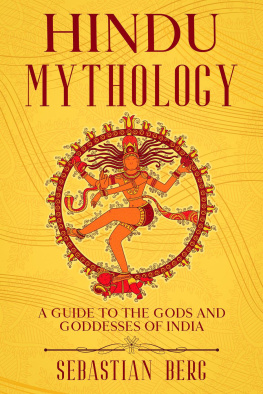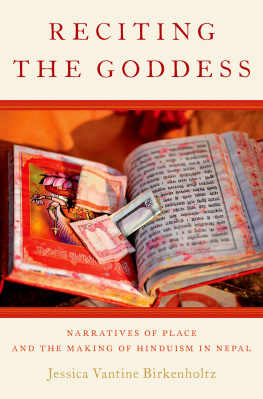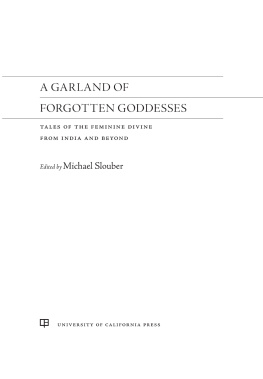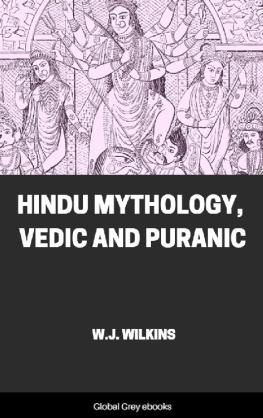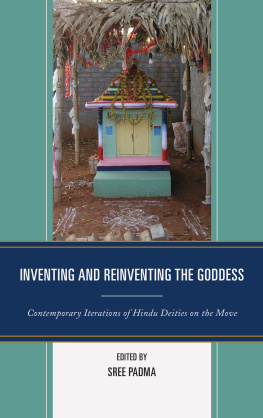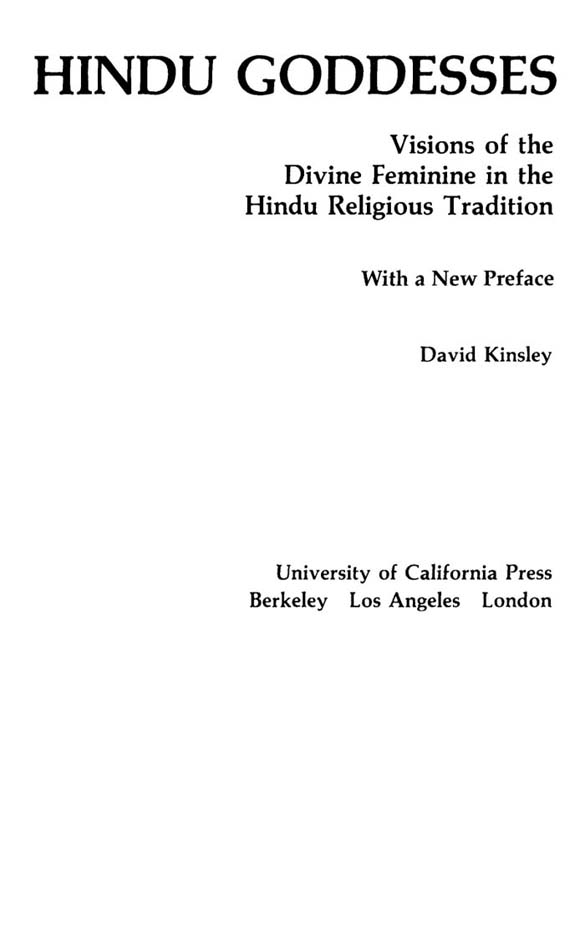HINDU GODDESSES
HINDU GODDESSES
Visions of the
Divine Feminine in the
Hindu Religious Tradition
With a New Preface
David Kinsley
University of California Press
Berkeley Los Angeles London
University of California Press Berkeley and Los Angeles, California
University of California Press, Ltd. London, England
First Paperback Printing 1988
Copyright 1986 by The Regents of the University of California
Library of Congress Cataloging in Publication Data
Kinsley, David R.
Hindu goddesses: visions of the divine feminine in the Hindu religious tradition / David R. Kinsley
Includes bibliographical references and index.
1. Goddesses, Hindu. I. Title.
BL1216.2K56 1985 294.5211 | 84-28000 |
ISBN 978-0-520-06339-6 (ppbk) | CIP |
Printed in the United States of America
16 15 14 13 12 11 10 09 08
18 17 16 15 14 13 12 11
The paper used in this publication is both acid-tree and totally chlorine-free (TCF). It meets the minimum requirements of ANSI/NISO Z39.48-1992 (R 1997) (Permanence of Paper).
To Margaret Airey and Louise Crittenden
Contents
PREFACE TO THE 1997 PRINTING
Looking back to my first thoughts about writing a book on Hindu goddesses, I am somewhat amused (but also pleased) that I had the courage to undertake such a daunting task. Ten years ago the project seemed much more feasible than it would today. In the past ten years there have been several excellent, lengthy, detailed studies of individual Hindu goddesses who were not even mentioned in my book, as well as many fine studies of goddesses who were included. New scholarship has indicated the immense number of Hindu goddesses and has greatly enriched our knowledge of prominent ones. Today, writing a comprehensive book on Hindu goddesses would be a much more ambitious undertaking; the result would be much longer and more detailedand, I suppose, less accessible to the general public.
The history of this book, however, pleases me. It was successful in the way I had hoped it would be. In the past decade, many fine scholars have turned their attention to Hindu goddesses. In many cases, this book was influential in attracting them to the field. It continues to serve as a useful introduction to a large and fascinating areathe divine feminine as expressed in the Hindu traditionand I hope it will continue to inspire students to take up its subject.
David Kinsley
INTRODUCTION
One of the most striking characteristics of the ancient and multifaceted Hindu religious tradition is the importance of goddess worship. A considerable number of goddesses are known in the earliest Hindu scriptures, the Vedic hymns. In contemporary Hinduism the number and popularity of goddesses are remarkable. No other living religious tradition displays such an ancient, continuous, and diverse history of goddess worship. The Hindu tradition provides the richest source of mythology, theology, and worship available to students interested in goddesses.
Although there are several books on the history of goddesses in India, but to my knowledge there is no study that attempts to describe and interpret all of the central Hindu goddesses. My approach in this book is to provide portraits of the most important goddesses of the Hindu pantheon. I have tried to suggest some of the history of each goddess, to summarize her most important myths and roles, and to show how she illustrates important Hindu (or human) truths. Although common themes occur in the myths, iconography, and functions of several of the goddesses treated in this book, each portrait is intended to be complete and to be appreciated by itself. The book need not be read in its entirety by people interested in just one or two of the Hindu goddesses. My intention is to provide a sourcebook on Hindu goddesses for students of the Hindu tradition and for those interested in goddesses in general.
The book also seeks to be a sourcebook for the growing study of women and religion. In recent years, especially in North America, considerable interest has developed in this field. A whole new area of religious studies now focuses on the ways in which women are perceived in I hope that it will make Hindu visions of the feminine accessible to those interested in such pursuits.
This book does not pretend to be exhaustive on the subject of goddesses in Hinduism. The number of goddesses in contemporary Hinduism alone is simply overwhelming. Nor does it pretend to be exhaustive of any of the particular goddesses who are included. Most of the ones I discuss have been known and widely worshiped for hundreds of years, some of them for thousands of years. Rather, this book seeks to represent the nature and diversity of goddess worship in Hinduism and to include all of the most important Hindu goddesses.
My primary sources have been literary and to some extent iconographical. I am aware that my views of the divine feminine in Hinduism may thus be slanted in the direction of the so-called great tradition, namely, the tradition that is high caste, educated, and predominantly male. In many cases, however, the only information that we have on some goddesses and on certain aspects of other goddesses, or the only information that we have from the past, is found in such sources. The chapter on village goddesses, which draws on the work of anthropologists and sociologists, suggests a quite different vision of the divine feminine from those visions underlying the great goddesses of the Hindu pantheon. Nevertheless, this book is out of necessity weighted toward the literary stream of the Hindu tradition, which tends to ignore or look with suspicion on popular worship, in which goddesses are widely revered.
This book does not try to present the material on goddesses in a historical or chronological way. Although I begin the book by discussing the evidence for goddess worship in Vedic literature and close the study with a treatment of village goddesses which suggests a look at the modern situation, the order in which I treat the most important Hindu goddesses is not meant to suggest a historical sequence. Only in very general terms is there a discernible historical progression. The earliest evidence of goddess worship in Hinduism is discussed first. The main sources here are Vedic texts. In these sources no goddesses of great popularity or prominence appear. This situation persists in the Hindu literary tradition till after the epic period. Sometime around the fifth or sixth century A.D., however, several goddesses suddenly appear in iconographic and literary sources in situations of great importance, which indicates an acceptance (or resurgence) of goddess worship in the Hindu tradition. All the individual goddesses that I discuss in the book (with the possible exception of Rdh) are important from that period to the present: r-Lakm, Prvat, Sarasvat, St, Durg, Kl, the Mtks, and such geographical goddesses as Gag. The central focus of the book is on these goddesses, and chapters treating them form the bulk of the work. The chapters on geographical goddesses, groups of goddesses, and village goddesses shift the focus of the book toward the present and rely more on the work of contemporary observers of Hinduism. Only in this limited way, then, might the book be seen to have a very general historical or developmental character.
My interest in Hindu goddesses dates to 1968, when I went to India to undertake doctoral research on the worship, mythology, and theology of Ka. During that year in India I was struck by the number of goddesses popular in Bengal, by my lack of knowledge about them, and also by the central role that Rdh played in Bengal Vaiavism. My first systematic attempt to study a Hindu goddess focused on Kl. Despite her popularity in the Hindu tradition, very little scholarly research had been done on her. I have found a similar absence of research on other important and popular Hindu goddesses.



